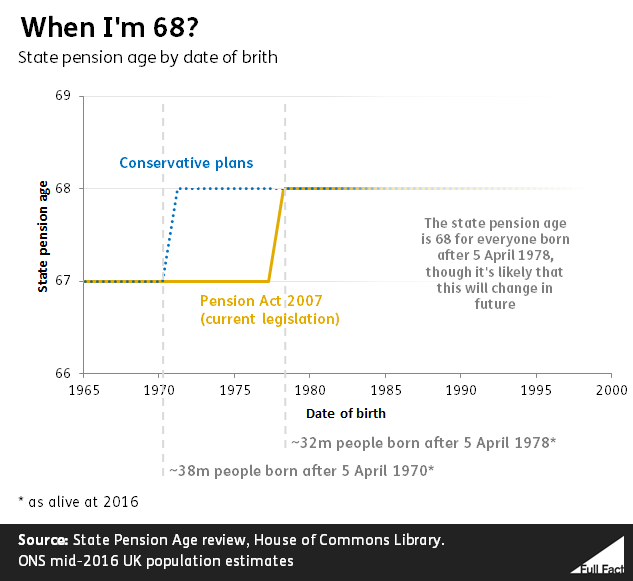“Thanks to the Tories increasing the State Pension age, 36.9 million people will be forced to work longer, at the same time that evidence indicates life expectancy has stalled in some places and is reducing in others.”
Debbie Abrahams MP 15 August 2017
An independent review of the UK state pension age recommended recently that it should rise from 67 to 68 between 2037 and 2039.
Under current law the state pension age is set to rise from 66 to 67 between 2026 and 2028 and to 68 between 2044 and 2046. This last change was set out in the Pension Act 2007 under the last Labour government. In effect, the review recommends that the current timetable to raise the pension age be brought forward by seven years.
The Government has said it intends to follow these recommendations, though they would need to be approved by Parliament before becoming law.
Honesty in public debate matters
You can help us take action – and get our regular free email
Who is affected?
Labour implies that the proposed change would see 36.9 million people having to work longer. This isn’t correct.
As the state pension age was already set to increase to 68 due to earlier legislation, raising it earlier only affects those people whose pension age wasn’t already 68.
The government’s proposals would mean the number of people who have a pensionable age higher than 66 years is 38 million people (those in the UK born after 5 April 1970), up from 32 million as it currently stands (those born after 5 April 1978). Nothing will change for those born after 5 April 1978 as their state pension age is already 68.
Raising the state pension age sooner therefore changes the circumstances of just those people born between 6 April 1970 and 5 April 1978, around six million people.
These figures are based on the number of people alive in the UK in 2016, using the mid-2016 UK population estimates from the ONS. If we ignore early deaths, migration and pension eligibility, they’re a reasonable guess for the number of people who will be affected by the changes.
Labour used mid-2015 population estimates rather than mid-2016. This is why they say around 37 million people rather than 38 million people. Using either version, the correct figure for the number of people affected by the proposed changes is about six million.

Labour has said they will keep the state pension age at 66, but it’s not clear if this means simply maintaining legislation as it currently stands (including the pension age rise in 2044) or reversing the existing laws. We’ve asked for clarification, though they said they would commission a new review in their 2017 election manifesto.
Why should the state pension age change?
The state pension age is, by law, regularly reviewed to ensure it is “affordable and fair”.
The biggest factor in setting the state pension age is life expectancy. As people live longer, they spend more of their life over the state pension age and this becomes increasingly unsustainable in terms of government spending if the state pension age is fixed.
The review earlier this year took account of changes to life expectancy in its recommendations, and a principle established by the Government in 2013 that people should on average expect to spend “up to one third of their adult life in receipt of the state pension”.
However, Labour argues that life expectancy rises have stalled and “there is no evidential basis for bringing the state pension age further forward”, citing a recent report by Public Health England.
It’s correct that life expectancy rises aren’t as steep as they have been, and have flat-lined in some areas. Other areas do show a small decrease but, due to uncertainty in these figures, suggestions that life expectancy is truly falling in these areas are probably premature.
